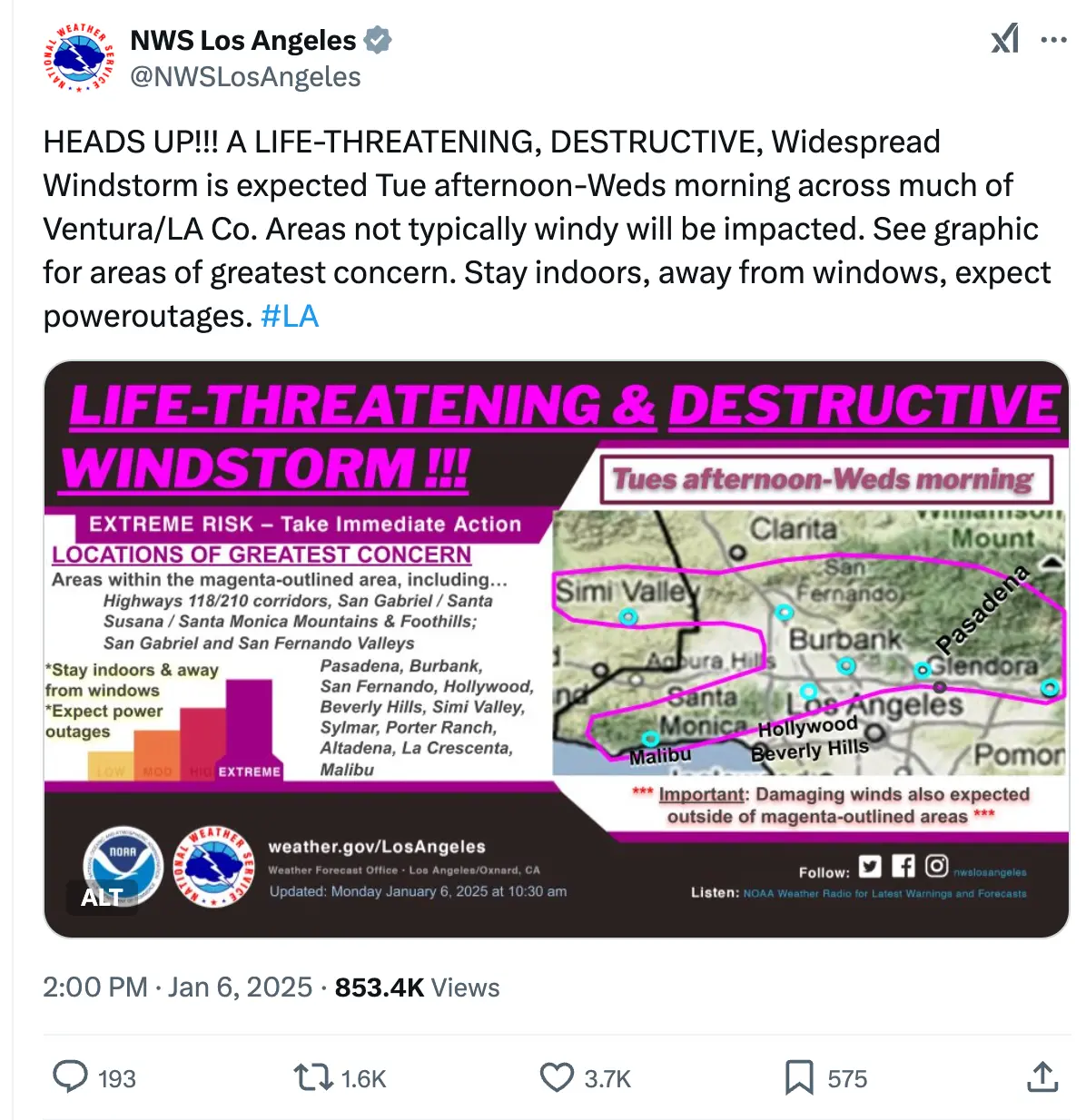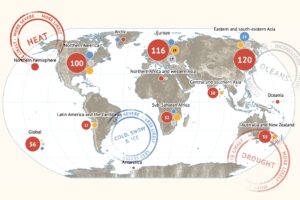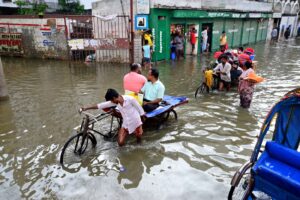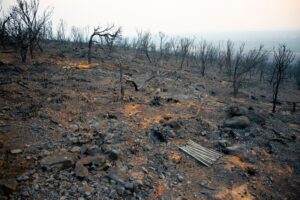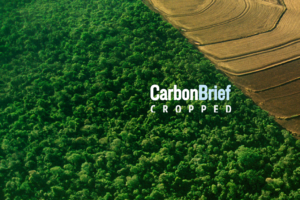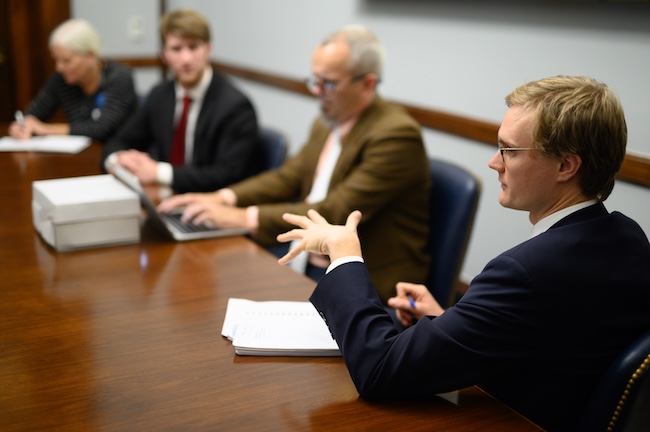More than a dozen wildfires have been sweeping through Los Angeles in California, consuming tens of thousands of acres of land and devastating some of the wealthiest neighbourhoods in the US.
As firefighters battle to contain the blazes, at least 24 people have died, while tens of thousands of people have been forced to evacuate and thousands of properties have been razed to the ground.
The disaster has received widespread attention across international media, covering the scale of the damage through to the causes of the fires – and the political spats they have triggered.
Both US president Joe Biden and his Californian vice-president Kamala Harris made the link between climate change and the fires.
Meanwhile, many scientists have pointed to “climate whiplash” – rapid switches from wet to dry conditions that are becoming more common in a warmer climate – as a factor in the scale of the devastation.
Many outlets have highlighted misleading claims by right-wing commentators about the Los Angeles fire department, as well as statements from incoming president Donald Trump casting blame on California’s Democratic governor, Gavin Newsom.
A number of outlets have also explored the impact of the wildfires – which have already been dubbed the costliest in US history – on the state’s already-fragile property insurance market.
In this article, Carbon Brief examines the role of climate change in the Los Angeles wildfires and how the media has covered the disaster.
- How did the wildfires develop around Los Angeles?
- How were the fires ignited?
- What have been the impacts of the fires?
- Does climate change have a role in driving the fires?
- What has been the political reaction?
- How has the media responded to the wildfires?
- What are the implications for insurance in the state?
How did the wildfires develop around Los Angeles?
Over the course of just a week in early January, multiple fires erupted in and around Los Angeles in southern California.
The first – and what became the largest – wildfire was the Palisades fire. This was first reported at around 10:30am on Tuesday 7 January and quickly spread, explained the Washington Post, “as winds gust[ed] to about 50 mph in the area”.
The Financial Times reported that more than 29,000 acres [11,174 hectares] were burned on Tuesday in Palisades, “an affluent coastal community with some of the most expensive property in the US”. With thousands of homes at risk, evacuation orders were issued for around 30,000 people, according to the newspaper.
Rescuers were “forced to use a bulldozer to clear a path” through gridlocked, abandoned cars for emergency services to pass, reported the Times.
Through the day, a “life-threatening” windstorm “accelerated the fire’s spread across a parched landscape that has had very little rain in months”, the FT said. This storm was the “strongest to hit southern California in more than a decade”, the Associated Press noted.
An AP photographer reported seeing “multi-million dollar mansions on fire as helicopters overhead dropped water loads”.
The Washington Post described the Palisades fire as a “monster from the start”, noting that it spanned “the size of 150 football fields within half an hour and an area larger than Manhattan a day after that”.
On Tuesday night, a fast-moving fire broke out in the hills above Altadena near Eaton Canyon, reported the Los Angeles Times, prompting further evacuation orders.
The Eaton fire had “quickly grown to 200 acres” [81 hectares] by Tuesday night, said the Times, while “another fire had ignited in Sylmar, a suburb north-west of Los Angeles, and had already consumed 50 acres [20 hectares] with some nearby residents ordered to evacuate”.
These three fires – Palisade, Eaton and what would later be named the Hurst fire – would become the focus of media coverage, but a number of other fires, such as Kenneth, Archer, Sunset, Lidia, Woodley and Olivas, also ignited across the region through the week.
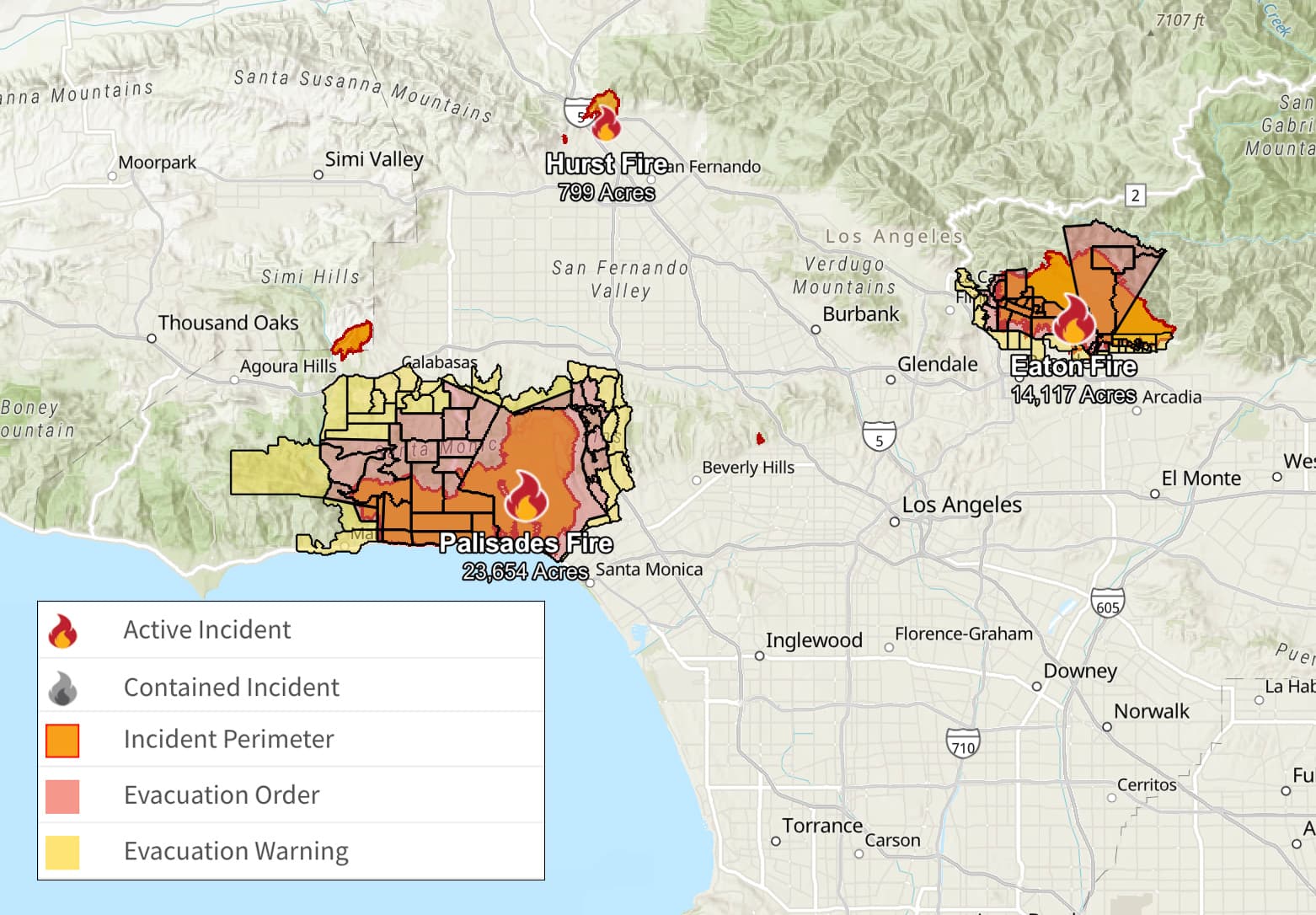
By Tuesday evening, California governor Gavin Newsom had declared a state of emergency, CBS News reported.
On Wednesday, the wildfires “burned uncontrollably across a wide swathe of greater Los Angeles”, reported the Washington Post, “transforming the landscape into scenes of apocalyptic destruction with blocks and blocks of neighborhoods reduced to ash”.
By the end of the day, more than 1,000 structures had been destroyed, at least 130,000 people were under evacuation orders and nearly 1.5 million residents were without power, the newspaper said. The fires were still raging with “almost zero containment”, it added.
The newspaper quoted Los Angeles county fire chief Anthony Marrone, who warned that his department was prepared for one or two major fires, but not for “this type of widespread disaster”. He added:
“There are not enough firefighters in LA county to address…fires of this magnitude.”
In response, firefighting teams from across California and the west “poured into the Los Angeles region in recent days to help relieve and reinforce local crews”, said the Washington Post.
Reports also emerged that firefighters were, in the words of BBC News, “struggl[ing] with water supply to their hoses and hydrants”. Reuters noted that “Los Angeles authorities said their municipal water systems were working effectively but they were designed for an urban environment, not for tackling wildfires”.
In total, at least a dozen fires have raged across the greater Los Angeles area over the past week. By Friday, the two largest fires of Palisades and Eaton were 8% and 3% contained, respectively, reported the Los Angeles Times. This increased to 11% and 15% by Saturday morning.
[As of early Monday 13 January (Pacific Standard Time), fire containment stood at 14%, 33% and 95% for the Palisades, Eaton and Hurst fires, respectively, according to California’s Department of Forestry and Fire Protection. All other fires have been contained.]
With more heavy winds expected this week, a local fire chief told BBC News that the fight against the blazes is “at a fork in the road”, warning that the fires could “take off on Tuesday or Wednesday”.
How were the fires ignited?
Investigators are still exploring the initial cause of the fires, reported the Associated Press.
While lightning is the “most common source of fires in the US…investigators were able to rule that out quickly”, the newswire said. It explained:
“There were no reports of lightning in the Palisades area or the terrain around the Eaton fire.”
The next two most-common causes are “fires intentionally set and those sparked by utility lines”, it added.
NBC News reported that the key to identifying the cause of the Palisades fire lies “on a brush-covered hilltop where the blaze broke out just after 10:30am on Tuesday”. A former battalion chief for the Los Angeles Fire Department told the outlet that arson was an unlikely cause:
“This is what we call inaccessible, rugged terrain…Arsonists usually aren’t going to go 500 feet off a trailhead through trees and brush, set a fire and then run away.”
Analysis by the Washington Post suggested the cause was an extinguished fire from New Year’s Eve. Combining photos, videos, satellite imagery, radio communications and interviews, the newspaper concluded that “the new fire started in the vicinity of the old fire, raising the possibility that the New Year’s Eve fire was reignited, which can occur in windy conditions”.
The Daily Mail picked up the Washington Post’s reporting, describing it as a “haunting new theory”.
Other fires, such as the Eaton fire, were linked to power lines, reported NBC News (link above):
“Whipping winds can cause the lines to slap together, shedding small balls of superhot molten metal.”
The Guardian noted that “it is routine for utilities to shut off power during ‘red-flag events’, but the power lines were on near the Eaton and Palisades fires” when they started last week.
However, NBC News said, this was just one theory, adding that “it’s also possible that it was started by a person operating a camping stove or a car or lawn mower that ejected a hot spark onto dry grass”.
What have been the impacts of the fires?
The fires that swept through Los Angeles have consumed more than 40,000 acres [16,187 hectares] of land, spread across a number of neighbourhoods in both the city and Los Angeles county, according to an update from the Washington Post on Monday 13 January.
The outlet also noted the fires had claimed the lives of 24 individuals at the latest count.
NPR added that more than 12,000 structures, including houses and businesses, had been destroyed by the fires over seven days.
In a separate article, the Washington Post mapped the wildfires in various areas in Los Angeles – Palisades, Eaton and Hurst. It noted that, as of 12 January, the Lidia, Sunset, Woodley, Archer and Kenneth fires had been contained.
In response to the fires, evacuation orders were issued for approximately 153,000 people in LA county, NBC Los Angeles reported.

The New York Times added that some evacuees found temporary housing in Los Angeles hotels, including a luxury hotel in Santa Monica and 19 hotels owned by the IHG chain, which includes Intercontinental, Regent and Holiday Inn.
Evacuations were ordered in “many parts of Pacific Palisades, Malibu, Santa Monica, Calabasas, Brentwood and Encino”, Los Angeles Times reported. Meanwhile, in areas including Glenoaks Canyon and Chevy Chase Canyon, evacuation orders were lifted, allowing residents to return to their homes, according to the outlet.
However, due to poor air quality affecting regions not directly impacted by the fires, schools in Los Angeles were cancelled on Friday, according to NBC Los Angeles. “Nearly all LA unified [school district] campuses and all offices would reopen Monday”, the Los Angeles Times added.
Cultural events have also been impacted, with the nominations for the 97th Academy Awards, and the Critics’ Choice Awards being postponed, as well as television shows such as Grey’s Anatomy and Jimmy Kimmel Live!, as reported by ABC News.
Meanwhile, an early estimate of total damages by insurance provider AccuWeather, widely cited in the media, including BBC News, predicts the fires have caused $135-150bn in total damages.
The fires are expected to have a major impact on California’s property insurance market. (See: What are the implications for insurance in Los Angeles?)
Does climate change have a role in driving the fires?
The severity and likelihood of wildfires are affected by a wide range of conditions. Some of these are related to the climate, such as temperature, wind speed and rainfall. Meanwhile, others are linked to land use, such as the density and type of vegetation, or human-implemented fire-suppression techniques.
Nevertheless, there is a wide body of evidence showing that climate change is making wildfire conditions more likely in many parts of the world. Attribution studies have revealed that climate change has already made many individual wildfires more intense or likely. However, no such attribution study has yet been published about the Los Angeles wildfires.
News outlets and experts across the world have been making the climate connection to the fires in recent days. Many outlets note that Los Angeles has seen rapid swings between extremely dry and wet conditions over the past few years.
BBC News reported that “decades of drought in California were followed by extremely heavy rainfall for two years in 2022 and 2023”, which allowed lots of vegetation to grow. However, the state saw a switch to very dry conditions in the autumn and winter of 2024, which dried out the vegetation, providing ideal fuel for the wildfire.
The outlet highlighted a timely academic paper, which explains that climate change has increased “hydroclimate whiplash” conditions – the rapid swings between periods of high and low rainfall – globally by 31-66% since the middle of the 20th century.
Dr Daniel Swain – a climate scientist from UCLA, who led the research – wrote a Bluesky thread explaining why climate “whiplash” can create the ideal conditions for fires to spread. He said:
“In coastal southern California, where grass and brush (including chaparral) are predominant vegetation types, there is actually a historical relationship between wetter winters and increased fire activity in [the] following fire season.”
Many outlets unpacked the rapid changes in California’s rainfall. The Guardian reported that in both the rainy seasons of 2023 and 2024, more than 25 inches of rain fell over southern California. However, it said this year’s rainy season “is running at just 2% of normal for Los Angeles, which has only seen 0.16in [4mm] of rain so far”.
Al Jazeera reported that, on 7 January, only 39% of California was completely drought-free, with the rest of the state described as “abnormally dry”. However, around the same time last year, 97% of the state was classed as “drought-free”, with only 3% classed as abnormally dry, it said.
Many outlets also pointed to the Santa Ana winds. According to the Guardian, these winds blow dry, warm air into California from the US western desert during cooler months, and have contributed to many forest fires in the past. The Associated Press reported that the winds were “much faster than normal” this year and have been “whipping flames and embers at 100mph – much faster than normal”.
BBC News reported that the low-humidity Santa Ana wind “strips the vegetation of a lot of its moisture, meaning that fire can catch quicker and the vegetation burn more readily”.
Inside Climate News said the “unusually warm” band of the Pacific Ocean near southern California is bending the jet stream, allowing high pressure to settle over the north-east of Los Angeles, while intensifying the Santa Ana winds.
In the Conversation, Prof Jon Keelet from the University of California, Los Angeles, explained his research, which shows a shift in the timing of Santa Ana winds. “Due to well-documented trends in climate change, it is tempting to ascribe this to global warming, but, as yet, there is no substantial evidence of this,” he said.
What has been the political reaction?
As the fires blazed, US president Joe Biden met with California’s Democratic governor, Gavin Newsom, and approved his request for a major disaster declaration, enabling increased federal funding, according to the Los Angeles Times.
When asked by NBC News if he thought these fires would be the worst “natural” disaster in US history, Newsom replied: “I think it will be just in terms of just the costs associated.”
Craig Fugate, the Federal Emergency Management Agency (FEMA) administrator under former president Barack Obama, told the Los Angeles Times that the fires were LA’s “Hurricane Katrina” – a moment that would “forever change the community”.
Bloomberg reported that Biden said federal support would cover 100% of the costs of the fire response for 180 days. The president also directed 400 additional federal firefighters and more than 30 helicopters and planes towards the region, the news outlet added.
Both Biden and his Californian vice-president Kamala Harris made the link between climate change and the fires in their public statements.
The wildfires come at a fraught political moment for the US. Biden, who has championed climate action during his presidency, will soon be replaced by Donald Trump, a climate sceptic who has vowed to roll back many of his predecessor’s policies.
Trump’s response to the fires was summarised in an Associated Press headline that stated: “As wildfires rage in LA, Trump doesn’t offer much sympathy. He’s casting blame.”
The article said Trump had taken aim at his “longtime political foe” and falsely blamed Newsom’s forest management policies and fish conservation efforts in California for the water shortages affecting the response effort . It added that Trump “has a history of withholding or delaying federal aid to punish his political enemies”.
The Los Angeles Times noted that both Biden and current FEMA administrator Deanne Criswell “stopped short” of guaranteeing that aid would continue under Trump.
Following the incoming president’s remarks, Newsom addressed a letter to Trump inviting him to visit LA fire victims and stating “we must not politicise human tragedy or spread disinformation”, according to the Los Angeles Times.
There were also claims in right-wing media that Democratic LA mayor Karen Bass had cut the fire department’s budget, but the Los Angeles Times noted that its budget “actually grew by more than 7%”. BBC News and Media Matters both ran articles fact-checking various claims made about Democrats by figures on the US right.
The Guardian reported on “misinformation” spread by the US right, including claims that the LA fire department prioritised “diversity schemes” – often referred to as “DEI” – over fighting fires. Elon Musk, Trump’s new “efficiency tsar”, supported such claims, and wrote on Twitter: “Wild theory: maybe, just maybe, the root cause wasn’t climate change?”
Meanwhile, another Guardian article noted that “nearby blue and red states as well as foreign countries are making their own political statements in their decisions to deploy firefighters to aid California”. CBS Austin reported that Republican Texas governor, Greg Abbott, has provided resources to California.
Canada and Mexico sent firefighters to help in California, with Canadian prime minister Justin Trudeau offering his nation’s “full support”. Trump has threatened to impose punitive tariffs on both nations.
How has the media responded to the fires?
There has been extensive coverage in the media of the wildfires, across the US and around the world.
This has taken many forms, but there has been a particular focus in editorials on political divisions and the role of climate denial. For example, an editorial in the Guardian argued that “political obstruction is deepening a climate crisis that needs urgent action”.
In the Washington Post, columnist Jennifer Rubin said that the fires should affect the spread of climate denial, “but won’t”. She wrote:
“The hellish fires tearing through the Los Angeles area are a preview of what’s to come if politicians, ideologues and big oil continue to ignore climate change…These sorts of horror shows will become routine if climate change deniers, led by the [Make America Great Again] anti-science crowd, get their way.”
Explainers on the role of climate change in the Los Angeles wildfires have formed a notable part of the media reaction. This included pieces from the Associated Press, Al Jazeera, Channel 4 News, Le Monde, Axios and the Los Angeles Times, among others.
Elsewhere, right-leaning, climate-sceptic media has called into question the role of climate change and conservation on the wildfires. Many have also criticised the Democratic government of California, as well as the Los Angeles fire chief and members of her department.
In the Daily Telegraph, Freddy Gray, deputy editor of the Spectator, argued that “the LA fires are an epitaph for Democrat misrule”, hitting out at the “climate change lobby” and arguing that the Biden administration “spent far too much time and resources pursuing politically correct causes at the expense of competent or even sane governance”.
An article in the New York Post hit out at Los Angeles mayor Karen Bass’s “botched response” to the fires. It also amplified the comments made across social media by celebrities such as actor James Woods, who claimed that “the fire is not from ‘climate change’” and instead blamed “liberal idiots” for electing “liberal idiots like Gavin Newsom and Karen Bass”.
As noted in a piece in Forbes, Youtubers have been among the right-wing influencers pushing criticism of fire department policy. For example, journalist Megyn Kelly – recently dubbed the “Rumplestiltskin of irritation” in Vox – alleged that the fire chief “has made not filling the fire hydrants top priority, but diversity” in a viral clip.
Similar misleading claims have been made on social media, including by Twitter CEO and leader of the new US Department of Government Efficiency Elon Musk, who, as noted above, argued the Los Angeles fire department “prioritised [DEI] over saving lives and homes”.
In response to the misinformation and disinformation being spread, there has also been a wave of articles attempting to counter or factcheck claims. This includes articles in the Guardian, the Los Angeles Times, BBC News and the Times, among others.
One specific aspect of the coverage of the Los Angeles wildfires has been the impact on celebrities, with the homes of Billy Crystal, Paris Hilton and Eugene Levy destroyed in the fires. As such, there has been a range of coverage from sources for whom disasters would generally fall outside their remit, including Hello!, Elle, TMZ and others.
An editorial in the Daily Mirror argued that “the destruction of celebrity mansions has captured attention, but we should not forget ordinary Americans”.
What are the implications for insurance in Los Angeles?
Media coverage has highlighted how the fires are set to deliver a major blow to the area’s property insurance market – seen as in “crisis” already – with major consequences for the Californian economy and households across the state.
Insured losses of the Los Angeles fires are expected to be in the tens of billions, according to early predictions from the insurance industry cited by Bloomberg and Reinsurance News.
The eye-watering damages are driven in part by Los Angeles’ expensive real estate. The National Post said the wildfires could prove to be “the costliest in US history, specifically because they have ripped through densely populated areas with higher end-properties”. Properties in the affected Palisades neighbourhood, for example, have a median home value of $3.1m, according to real-estate data cited in a CBS News report.
After wildfires in 2017 and 2018 decimated the industry’s profits, insurers have pulled back from California’s property insurance market in recent years, making it difficult for homeowners to find affordable cover. State Farm, Allstate and Farmers Insurance are among the insurers that have either dropped California policies or halted underwriting in recent years, CBS News said.
As a result, the Los Angeles Times said the fires threaten “to deepen a crisis that has already left hundreds of thousands of Californians struggling to find and keep affordable homeowners insurance”.
Meanwhile, the New Yorker said the “insurance crisis” has been “years in the making”, noting that people had been moving to wildfire-prone areas, despite fires “becoming more destructive, in large measure due to climate change”.
The retreat of insurers from California means a significant proportion of homeowners in Los Angeles rely on the state’s insurer of last resort, California’s Fair Access to Insurance Requirements (FAIR) plan.
There are now concerns the FAIR plan – which is run by the state government, but pools funds from insurers – could run out of money, putting private insurance firms on the hook to foot the bill. These costs – which could be as large as $24bn, according to the San Francisco Chronicle – would likely be passed on to insurance policyholders across the state.
The New York Times said such a scenario “would further strain the financial health of those insurers, adding to the pressure to pull back from the [California property insurance] market”. It adds:
“The potential consequences are huge. Without insurance, banks won’t issue a mortgage; without a mortgage, most people can’t buy a home. Fewer buyers mean falling home prices, threatening the tax base of fire-prone communities. It’s a scenario that could come to define California, as rising temperatures and drier conditions caused by climate change intensify the risk of wildfires.”
The Los Angeles Times said rising insurance costs for homeowners were just one way the fires would exacerbate the region’s “housing affordability crisis”. The paper has also pointed to higher rents and fierce competition for contractors that can rebuild destroyed and damaged properties.
The crisis comes as insurers around the world grapple with the rising costs attached to escalating climate impacts. Munich Re data – covered by Reuters – reveals that extreme weather events in 2024 caused an estimated $140bn in insured losses globally, up from $106bn the previous year.
Dave Jones, the former insurance commissioner of California and director of the Climate Risk Initiative at Berkeley School of Law, told Time the dynamics hurting California’s beleaguered insurance market could spread to other states as climate impacts intensified. He said:
“In the long term, we’re not doing enough to deal with the underlying driver, which is fossil fuels and greenhouse gas emissions, so we’re going to continue to see insurance unavailability throughout the US. We are marching steadily towards an uninsurable future in this country.”
The post Media reaction: The 2025 Los Angeles wildfires and the role of climate change appeared first on Carbon Brief.
Media reaction: The 2025 Los Angeles wildfires and the role of climate change
Greenhouse Gases
DeBriefed 15 August 2025: Raging wildfires; Xi’s priorities; Factchecking the Trump climate report
Welcome to Carbon Brief’s DeBriefed.
An essential guide to the week’s key developments relating to climate change.
This week
Blazing heat hits Europe
FANNING THE FLAMES: Wildfires “fanned by a heatwave and strong winds” caused havoc across southern Europe, Reuters reported. It added: “Fire has affected nearly 440,000 hectares (1,700 square miles) in the eurozone so far in 2025, double the average for the same period of the year since 2006.” Extreme heat is “breaking temperature records across Europe”, the Guardian said, with several countries reporting readings of around 40C.
HUMAN TOLL: At least three people have died in the wildfires erupting across Spain, Turkey and Albania, France24 said, adding that the fires have “displaced thousands in Greece and Albania”. Le Monde reported that a child in Italy “died of heatstroke”, while thousands were evacuated from Spain and firefighters “battled three large wildfires” in Portugal.
UK WILDFIRE RISK: The UK saw temperatures as high as 33.4C this week as England “entered its fourth heatwave”, BBC News said. The high heat is causing “nationally significant” water shortfalls, it added, “hitting farms, damaging wildlife and increasing wildfires”. The Daily Mirror noted that these conditions “could last until mid-autumn”. Scientists warn the UK faces possible “firewaves” due to climate change, BBC News also reported.
Around the world
- GRID PRESSURES: Iraq suffered a “near nationwide blackout” as elevated power demand – due to extreme temperatures of around 50C – triggered a transmission line failure, Bloomberg reported.
- ‘DIRE’ DOWN UNDER: The Australian government is keeping a climate risk assessment that contains “dire” implications for the continent “under wraps”, the Australian Financial Review said.
- EXTREME RAINFALL: Mexico City is “seeing one of its heaviest rainy seasons in years”, the Washington Post said. Downpours in the Japanese island of Kyushu “caused flooding and mudslides”, according to Politico. In Kashmir, flash floods killed 56 and left “scores missing”, the Associated Press said.
- SOUTH-SOUTH COOPERATION: China and Brazil agreed to “ensure the success” of COP30 in a recent phone call, Chinese state news agency Xinhua reported.
- PLASTIC ‘DEADLOCK’: Talks on a plastic pollution treaty have failed again at a summit in Geneva, according to the Guardian, with countries “deadlocked” on whether it should include “curbs on production and toxic chemicals”.
15
The number of times by which the most ethnically-diverse areas in England are more likely to experience extreme heat than its “least diverse” areas, according to new analysis by Carbon Brief.
Latest climate research
- As many as 13 minerals critical for low-carbon energy may face shortages under 2C pathways | Nature Climate Change
- A “scoping review” examined the impact of climate change on poor sexual and reproductive health and rights in sub-Saharan Africa | PLOS One
- A UK university cut the carbon footprint of its weekly canteen menu by 31% “without students noticing” | Nature Food
(For more, see Carbon Brief’s in-depth daily summaries of the top climate news stories on Monday, Tuesday, Wednesday, Thursday and Friday.)
Captured
Factchecking Trump’s climate report
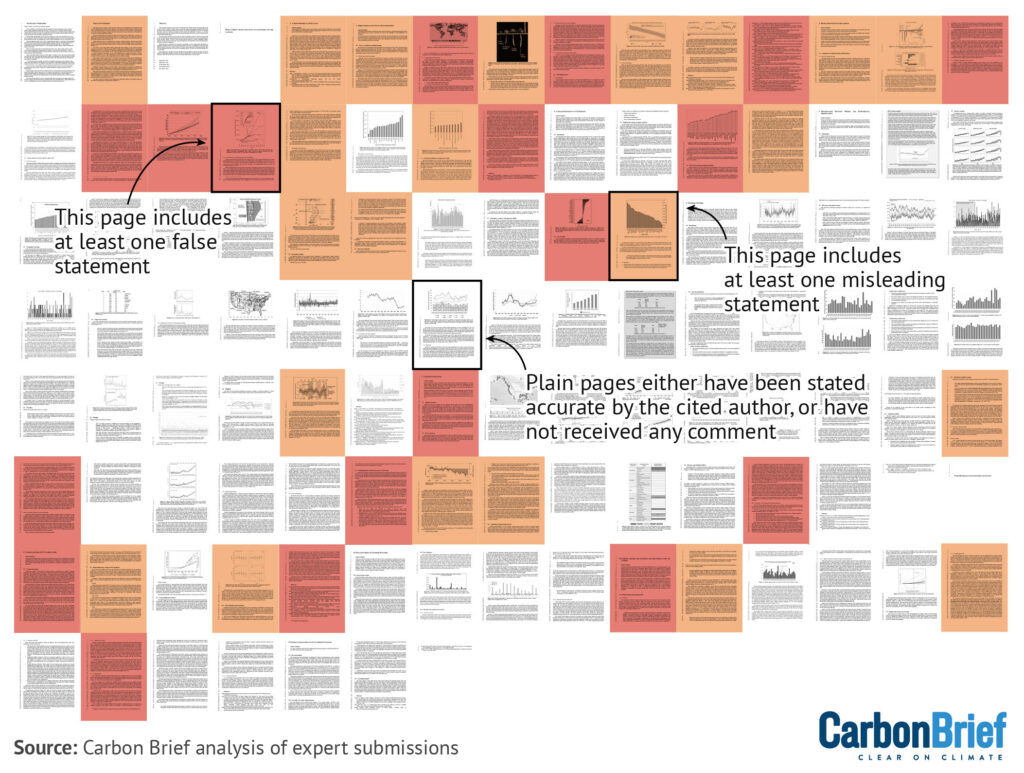
A report commissioned by the US government to justify rolling back climate regulations contains “at least 100 false or misleading statements”, according to a Carbon Brief factcheck involving dozens of leading climate scientists. The report, compiled in two months by five hand-picked researchers, inaccurately claims that “CO2-induced warming might be less damaging economically than commonly believed” and misleadingly states that “excessively aggressive [emissions] mitigation policies could prove more detrimental than beneficial”80
Spotlight
Does Xi Jinping care about climate change?
This week, Carbon Brief unpacks new research on Chinese president Xi Jinping’s policy priorities.
On this day in 2005, Xi Jinping, a local official in eastern China, made an unplanned speech when touring a small village – a rare occurrence in China’s highly-choreographed political culture.
In it, he observed that “lucid waters and lush mountains are mountains of silver and gold” – that is, the environment cannot be sacrificed for the sake of growth.
(The full text of the speech is not available, although Xi discussed the concept in a brief newspaper column – see below – a few days later.)
In a time where most government officials were laser-focused on delivering economic growth, this message was highly unusual.
Forward-thinking on environment
As a local official in the early 2000s, Xi endorsed the concept of “green GDP”, which integrates the value of natural resources and the environment into GDP calculations.
He also penned a regular newspaper column, 22 of which discussed environmental protection – although “climate change” was never mentioned.
This focus carried over to China’s national agenda when Xi became president.
New research from the Asia Society Policy Institute tracked policies in which Xi is reported by state media to have “personally” taken action.
It found that environmental protection is one of six topics in which he is often said to have directly steered policymaking.
Such policies include guidelines to build a “Beautiful China”, the creation of an environmental protection inspection team and the “three-north shelterbelt” afforestation programme.
“It’s important to know what Xi’s priorities are because the top leader wields outsized influence in the Chinese political system,” Neil Thomas, Asia Society Policy Institute fellow and report co-author, told Carbon Brief.
Local policymakers are “more likely” to invest resources in addressing policies they know have Xi’s attention, to increase their chances for promotion, he added.
What about climate and energy?
However, the research noted, climate and energy policies have not been publicised as bearing Xi’s personal touch.
“I think Xi prioritises environmental protection more than climate change because reducing pollution is an issue of social stability,” Thomas said, noting that “smoggy skies and polluted rivers” were more visible and more likely to trigger civil society pushback than gradual temperature increases.
The paper also said topics might not be linked to Xi personally when they are “too technical” or “politically sensitive”.
For example, Xi’s landmark decision for China to achieve carbon neutrality by 2060 is widely reported as having only been made after climate modelling – facilitated by former climate envoy Xie Zhenhua – showed that this goal was achievable.
Prior to this, Xi had never spoken publicly about carbon neutrality.
Prof Alex Wang, a University of California, Los Angeles professor of law not involved in the research, noted that emphasising Xi’s personal attention may signal “top” political priorities, but not necessarily Xi’s “personal interests”.
By not emphasising climate, he said, Xi may be trying to avoid “pushing the system to overprioritise climate to the exclusion of the other priorities”.
There are other ways to know where climate ranks on the policy agenda, Thomas noted:
“Climate watchers should look at what Xi says, what Xi does and what policies Xi authorises in the name of the ‘central committee’. Is Xi talking more about climate? Is Xi establishing institutions and convening meetings that focus on climate? Is climate becoming a more prominent theme in top-level documents?”
Watch, read, listen
TRUMP EFFECT: The Columbia Energy Exchange podcast examined how pressure from US tariffs could affect India’s clean energy transition.
NAMIBIAN ‘DESTRUCTION’: The National Observer investigated the failure to address “human rights abuses and environmental destruction” claims against a Canadian oil company in Namibia.
‘RED AI’: The Network for the Digital Economy and the Environment studied the state of current research on “Red AI”, or the “negative environmental implications of AI”.
Coming up
- 17 August: Bolivian general elections
- 18-29 August: Preparatory talks on the entry into force of the “High Seas Treaty”, New York
- 18-22 August: Y20 Summit, Johannesburg
- 21 August: Advancing the “Africa clean air programme” through Africa-Asia collaboration, Yokohama
Pick of the jobs
- Lancaster Environment Centre, senior research associate: JUST Centre | Salary: £39,355-£45,413. Location: Lancaster, UK
- Environmental Justice Foundation, communications and media officer, Francophone Africa | Salary: XOF600,000-XOF800,000. Location: Dakar, Senegal
- Politico, energy & climate editor | Salary: Unknown. Location: Brussels, Belgium
- EnviroCatalysts, meteorologist | Salary: Unknown. Location: New Delhi, India
DeBriefed is edited by Daisy Dunne. Please send any tips or feedback to debriefed@carbonbrief.org.
This is an online version of Carbon Brief’s weekly DeBriefed email newsletter. Subscribe for free here.
The post DeBriefed 15 August 2025: Raging wildfires; Xi’s priorities; Factchecking the Trump climate report appeared first on Carbon Brief.
DeBriefed 15 August 2025: Raging wildfires; Xi’s priorities; Factchecking the Trump climate report
Greenhouse Gases
Cropped 13 August 2025: Fossil-fuelled bird decline; ‘Deadly’ wildfires; Empty nature fund
We handpick and explain the most important stories at the intersection of climate, land, food and nature over the past fortnight.
This is an online version of Carbon Brief’s fortnightly Cropped email newsletter. Subscribe for free here.
Key developments
‘Deadly’ wildfires
WINE BRAKE: France experienced its “largest wildfire in decades”, which scorched more than 16,000 hectares in the country’s southern Aude region, the Associated Press said. “Gusting winds” fanned the flames, Reuters reported, but local winemakers and mayors also “blam[ed] the loss of vineyards”, which can act as a “natural, moisture-filled brake against wildfires”, for the fire’s rapid spread. It added that thousands of hectares of vineyards were removed in Aude over the past year. Meanwhile, thousands of people were evacuated from “deadly” wildfires in Spain, the Guardian said, with blazes ongoing in other parts of Europe.
MAJOR FIRES: Canada is experiencing its second-worst wildfire season on record, CBC News reported. More than 7.3m hectares burned in 2025, “more than double the 10-year average for this time of year”, the broadcaster said. The past three fire seasons were “among the 10 worst on record”, CBC News added. Dr Mike Flannigan from Thompson Rivers University told the Guardian: “This is our new reality…The warmer it gets, the more fires we see.” Elsewhere, the UK is experiencing a record year for wildfires, with more than 40,000 hectares of land burned so far in 2025, according to Carbon Brief.
-
Sign up to Carbon Brief’s free “Cropped” email newsletter. A fortnightly digest of food, land and nature news and views. Sent to your inbox every other Wednesday.
WESTERN US: The US state of Colorado has recorded one of its largest wildfires in history in recent days, the Guardian said. The fire “charred” more than 43,300 hectares of land and led to the temporary evacuation of 179 inmates from a prison, the newspaper said. In California, a fire broke out “during a heatwave” and burned more than 2,000 hectares before it was contained, the Los Angeles Times reported. BBC News noted: “Wildfires have become more frequent in California, with experts citing climate change as a key factor. Hotter, drier conditions have made fire seasons longer and more destructive.”
FIRE FUNDING: “Worsening fires” in the Brazilian Amazon threaten new rainforest funding proposals due to be announced at the COP30 climate summit later this year, experts told Climate Home News. The new initiatives include the Tropical Forests Forever Facility, which the outlet said “aims to generate a flow of international investment to pay countries annually in proportion to their preserved tropical forests”. The outlet added: “If fires in the Amazon continue to worsen in the years to come, eligibility for funding could be jeopardised, Brazil’s environment ministry acknowledged.”
Farming impacts
OUT OF ORBIT: US president Donald Trump moved to “shut down” two space missions which monitor carbon dioxide and plant health, the Associated Press reported. Ending these NASA missions would “potentially shu[t] off an important source of data for scientists, policymakers and farmers”, the outlet said. Dr David Crisp, a retired NASA scientist, said the missions can detect the “glow” of plant growth, which the outlet noted “helps monitor drought and predict food shortages that can lead to civil unrest and famine”.
FARM EXTREMES: Elsewhere, Reuters said that some farmers are considering “abandoning” a “drought-hit” agricultural area in Hungary as “climate change cuts crop yields and reduces groundwater levels”. Scientists warned that rising temperatures and low rainfall threaten the region’s “agricultural viability”, the newswire added. Meanwhile, the Premium Times in Nigeria said that some farmers are “harvest[ing] crops prematurely” due to flooding fears. A community in the south-eastern state of Imo “has endured recurrent floods, which wash away crops and incomes alike” over the past decade, the newspaper noted.
SECURITY RISKS: Food supply chains in the UK face “escalating threats from climate impacts and the migration they are triggering”, according to a report covered by Business Green. The outlet said that £3bn worth of UK food imports originated from the 20 countries “with the highest numbers of climate-driven displacements” in 2024, based on analysis from the Energy and Climate Intelligence Unit. The analysis highlighted that “climate impacts on food imports pose a threat to UK food security”. Elsewhere, an opinion piece in Dialogue Earth explored how the “role of gender equity in food security remains critically unaddressed”.
Spotlight
Fossil-fuelled bird decline
This week, Carbon Brief covers a new study tracing the impact of fossil-fuelled climate change on tropical birds.
Over the past few years, biologists have recorded sharp declines in bird numbers across tropical rainforests – even in areas untouched by humans – with the cause remaining a mystery.
A new study published this week in Nature Ecology and Evolution could help to shed light on this alarming phenomenon.
The research combined ecological and climate attribution techniques for the first time to trace the fingerprint of fossil-fuelled climate change on declining bird populations.
It found that an increase in heat extremes driven by climate change has caused tropical bird populations to decline by 25-38% in the period 1950-2020, when compared to a world without warming.
In their paper, the authors noted that birds in the tropics could be living close to their “thermal limits”.
Study lead author Dr Maximilian Kotz, a climate scientist at the Barcelona Supercomputing Center in Spain, explained to Carbon Brief:
“High temperature extremes can induce direct mortality in bird populations due to hyperthermia and dehydration. Even when they don’t [kill birds immediately], there’s evidence that this can then affect body condition which, in turn, affects breeding behaviour and success.”
Conservation implications
The findings have “potential ramifications” for commonly proposed conservation strategies, such as increasing the amount of land in the tropics that is protected for nature, the authors said. In their paper, they continued:
“While we do not disagree that these strategies are necessary for abating tropical habitat loss…our research shows there is now an additional urgent need to investigate strategies that can allow for the persistence of tropical species that are vulnerable to heat extremes.”
In some parts of the world, scientists and conservationists are looking into how to protect wildlife from more intense and frequent climate extremes, Kotz said.
He referenced one project in Australia which is working to protect threatened wildlife following periods of extreme heat, drought and bushfires.
Prof Alex Pigot, a biodiversity scientist at University College London (UCL), who was not involved in the research, said the findings reinforced the need to systematically monitor the impact of extreme weather on wildlife. He told Carbon Brief:
“We urgently need to develop early warning systems to be able to anticipate in advance where and when extreme heatwaves and droughts are likely to impact populations – and also rapidly scale up our monitoring of species and ecosystems so that we can reliably detect these effects.”
There is further coverage of this research on Carbon Brief’s website.
News and views
EMPTY CALI FUND: A major voluntary fund for biodiversity remains empty more than five months after its launch, Carbon Brief revealed. The Cali Fund, agreed at the COP16 biodiversity negotiations last year, was set up for companies who rely on nature’s resources to share some of their earnings with the countries where many of these resources originate. Big pharmaceutical companies did not take up on opportunities to commit to contributing to the fund or be involved in its launch in February 2025, emails released to Carbon Brief showed. Just one US biotechnology firm has pledged to contribute to the fund in the future.
LOSING HOPE: Western Australia’s Ningaloo reef – long considered a “hope spot” among the country’s coral reefs for evading major bleaching events – is facing its “worst-ever coral bleaching”, Australia’s ABC News reported. The ocean around Ningaloo has been “abnormally” warm since December, resulting in “unprecedented” bleaching and mortality, a research scientist told the outlet. According to marine ecologist Dr Damian Thomson, “up to 50% of the examined coral was dead in May”, the Sydney Morning Herald said. Thomson told the newspaper: “You realise your children are probably never going to see Ningaloo the way you saw it.”
‘DEVASTATION BILL’: Brazil’s president, Luiz Inácio Lula da Silva, signed a “contentious” environmental bill into law, but “partially vetoed” some of the widely criticised elements, the Financial Times reported. Critics, who dubbed it the “devastation bill”, said it “risked fuelling deforestation and would harm Brazil’s ecological credentials” just months before hosting the COP30 climate summit. The newspaper said: “The leftist leader struck down or altered 63 of 400 provisions in the legislation, which was designed to speed up and modernise environmental licensing for new business and infrastructure developments.” The vetoes need to be approved by congress, “where Lula lacks a majority”, the newspaper noted.
RAINFOREST DRILLING: The EU has advised the Democratic Republic of the Congo (DRC) against allowing oil drilling in a vast stretch of rainforest and peatland that was jointly designated a “green corridor” earlier this year, Climate Home News reported. In May, the DRC announced that it planned to open the conservation area for drilling, the publication said. A spokesperson for the European Commission told Climate Home News that the bloc “fully acknowledges and respects the DRC’s sovereign right to utilise its diverse resources for economic development”, but that it “highlights the fact that green alternatives have facilitated the protection of certain areas”.
NEW PLAN FOR WETLANDS: During the 15th meeting of the Ramsar Convention on Wetlands, held in Zimbabwe from 23 to 31 July, countries agreed on the adoption of a new 10-year strategic plan for conserving and sustainably using the world’s wetlands. Down to Earth reported that 13 resolutions were adopted, including “enhancing monitoring and reporting, capacity building and mobilisation of resources”. During the talks, Zimbabwe’s environment minister announced plans to restore 250,000 hectares of degraded wetlands by 2030 and Saudi Arabia entered the Convention on Wetlands. Panamá will host the next COP on wetlands in July 2028.
MEAT MADNESS: DeSmog covered the details of a 2021 public relations document that revealed how the meat industry is trying to “make beef seem climate-friendly”. The industry “may have enlisted environmental groups to persuade people to ‘feel better’ about eating beef”, the outlet said, based on this document. The strategy was created by a communications agency, MHP Group, and addressed to the Global Roundtable for Sustainable Beef. One of the key messages of the plan was to communicate the “growing momentum in the beef industry to protect and nurture the Earth’s natural resources”. MHP Group did not respond to a request for comment, according to DeSmog.
Watch, read, listen
MAKING WAVES: A livestream of deep-sea “crustaceans, sponges and sea cucumbers” has “captivated” people in Argentina, the New York Times outlined.
BAFFLING BIRDS: The Times explored the backstory to the tens of thousands of “exotic-looking” parakeets found in parks across Britain.
PLANT-BASED POWER: In the Conversation, Prof Paul Behrens outlined how switching to a plant-based diet could help the UK meet its climate and health targets.
MARINE DISCRIMINATION: Nature spoke to a US-based graduate student who co-founded Minorities in Shark Science about her experiences of racism and sexism in the research field.
New science
- Applying biochar – a type of charcoal – to soils each year over a long period of time can have “sustained benefits for crop yield and greenhouse gas mitigation”, according to a Proceedings of the National Academy of Sciences study.
- New research, published in PLOS Climate, found that nearly one-third of highly migratory fish species in the US waters of the Atlantic Ocean have “high” or “very high” vulnerability to climate change, but the majority of species have “some level of resilience and adaptability”.
- A study in Communications Earth & Environment found a “notable greening trend” in China’s wetlands over 2000-23, with an increasing amount of carbon being stored in the plants growing there.
In the diary
- 18-29 August: Second meeting of the preparatory commission for the Agreement on Marine Biological Diversity of Areas beyond National Jurisdiction | New York
- 24-28 August: World Water Week | Online and Stockholm, Sweden
- 26-29 August: Sixth forum of ministers and environment authorities of Asia Pacific | Nadi, Fiji
Cropped is researched and written by Dr Giuliana Viglione, Aruna Chandrasekhar, Daisy Dunne, Orla Dwyer and Yanine Quiroz. Please send tips and feedback to cropped@carbonbrief.org
The post Cropped 13 August 2025: Fossil-fuelled bird decline; ‘Deadly’ wildfires; Empty nature fund appeared first on Carbon Brief.
Cropped 13 August 2025: Fossil-fuelled bird decline; ‘Deadly’ wildfires; Empty nature fund
Greenhouse Gases
Holding the line on climate: EPA
CCL submits a formal comment on EPA’s proposed endangerment finding rollback
By Dana Nuccitelli, CCL Research Manager
On July 29, the EPA proposed to rescind its 2009 endangerment finding that forms the basis of all federal climate pollution regulations.
Without the endangerment finding, the EPA may not be allowed or able to regulate greenhouse gas pollution from sources like power plants or vehicle tailpipes, as they have done for years. News coverage has framed this as a “radical transformation” and a “bid to scrap almost all pollution regulations,” so it has appropriately alarmed many folks in the climate and environment space.
At CCL, we focus our efforts on working with Congress to implement durable climate policies, and so we don’t normally take actions on issues like this that relate to federal agencies or the courts. Other organizations focus their efforts on those branches of the government and are better equipped to spearhead this type of moment, and we appreciate those allies.
But in this case, we did see an opportunity for CCL’s voice — and our focus on Congress — to play a role here. We decided to submit a formal comment on this EPA action for two reasons.
First, this decision could have an immense impact by eliminating every federal regulation of climate pollutants in a worst case scenario. Second, this move relates to our work because the EPA is misinterpreting the text and intent of laws passed by Congress. Our representatives have done their jobs by passing legislation over the past many decades that supports and further codifies the EPA’s mandate to regulate climate pollution. That includes the Clean Air Act, and more recently, the Inflation Reduction Act. We at CCL wanted to support our members of Congress by making these points in a formal comment.
There has been a tremendous public response to this action. In just over one week, the EPA already received over 44,000 public comments on its decision, and the public comment period will remain open for another five weeks, until September 15.
To understand more about the details and potential outcomes of the EPA’s actions, read my article on the subject at Yale Climate Connections, our discussion on CCL Community, and CCL’s formal comment, which represents our entire organization. As our comment concludes,
“In its justifications for rescinding the 2009 endangerment finding, the Reconsideration has misinterpreted the text of the Clean Air Act, Congress’ decadeslong support for the EPA’s mandate to regulate greenhouse gas emissions from motor vehicles and other major sources, and the vast body of peer-reviewed climate science research that documents the increasingly dangerous threats that those emissions pose to Americans’ health and welfare. Because the bases of these justifications are fundamentally flawed, CCL urges the EPA to withdraw its ill-conceived Reconsideration of the 2009 endangerment finding. The EPA has both the authority and the responsibility to act. Americans cannot afford a retreat from science, law, and common sense in the face of a rapidly accelerating climate crisis.”
After the EPA responds to the public comment record and finalizes its decision, this issue will ultimately be decided by the Supreme Court several years from now.
In the meantime, CCL will continue to focus our efforts on areas where we can make the biggest difference in preserving a livable climate. Right now, that involves contacting our members of Congress to urge them to fully fund key climate and energy programs and protect critical work at the National Oceanic and Atmospheric Administration (NOAA), National Aeronautics and Space Administration (NASA), and Department of Energy. We’ve set an ambitious goal of sending 10,000 messages to our members of Congress, so let’s all do what CCL does best and make our voices heard on this critical issue.
This action by the EPA also reminds us that federal regulations are fragile. They tend to change with each new administration coming into the White House. Legislation passed by Congress – especially when done on a bipartisan basis – is much more durable. That’s why CCL’s work, as one of very few organizations engaging in nonpartisan advocacy for long-lasting climate legislation, is so critical.
That’s especially true right now when we’re seeing the Trump administration slam shut every executive branch door to addressing climate change. We need Congress to step up now more than ever to implement durable solutions like funding key climate and energy programs, negotiating a new bipartisan comprehensive permitting reform bill, implementing healthy forest solutions like the Fix Our Forests Act, and advancing conversations about policies to put a price on carbon pollution. Those are the kinds of effective, durable, bipartisan climate solutions that CCL is uniquely poised to help become law and make a real difference in preserving a livable climate.
For other examples of how CCL is using our grassroots power to help ensure that Congress stays effective on climate in this political landscape, see our full “Holding the Line on Climate” blog series.
The post Holding the line on climate: EPA appeared first on Citizens' Climate Lobby.
-
Climate Change2 years ago
Spanish-language misinformation on renewable energy spreads online, report shows
-
Climate Change Videos2 years ago
The toxic gas flares fuelling Nigeria’s climate change – BBC News
-

 Greenhouse Gases1 year ago
Greenhouse Gases1 year ago嘉宾来稿:满足中国增长的用电需求 光伏加储能“比新建煤电更实惠”
-

 Climate Change1 year ago
Climate Change1 year ago嘉宾来稿:满足中国增长的用电需求 光伏加储能“比新建煤电更实惠”
-

 Carbon Footprint1 year ago
Carbon Footprint1 year agoUS SEC’s Climate Disclosure Rules Spur Renewed Interest in Carbon Credits
-
Climate Change2 years ago
Why airlines are perfect targets for anti-greenwashing legal action
-
Climate Change Videos2 years ago
The toxic gas flares fuelling Nigeria’s climate change – BBC News
-
Climate Change2 years ago
Some firms unaware of England’s new single-use plastic ban

